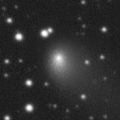
|
Now it is 9.7 mag (Dec. 18, Carlos Labordena). It is expected to brighten up to 8 mag in 2020. It stays observable in good condition for a long time in the Northern Hemisphere. In the Southern Hemisphere, it is not observable until July.
Date(TT) R.A. (2000) Decl. Delta r Elong. m1 Best Time(A, h)
Dec. 21 4 0.54 52 54.7 1.529 2.393 143 9.5 22:01 (180, 2)
Dec. 28 3 38.07 54 29.6 1.520 2.331 136 9.4 21:11 (180, 0)
|

|
Now it is 11.8 mag (Dec. 18, Maik Meyer). It stays bright as 11 mag until January. It stays observable in good condition for a long time in the Northern Hemisphere. In the Southern Hemisphere, it will never be observable again.
Date(TT) R.A. (2000) Decl. Delta r Elong. m1 Best Time(A, h)
Dec. 21 23 32.70 39 21.3 2.812 3.149 100 11.7 20:59 (143, 2)
Dec. 28 23 30.36 39 33.6 2.918 3.158 94 11.8 21:03 (138, -3)
|

|
Now it is 14.5 mag (Dec. 4, Toshihiko Ikemura, Hirohisa Sato).
Date(TT) R.A. (2000) Decl. Delta r Elong. m1 Best Time(A, h)
Dec. 21 0 26.29 12 51.3 5.490 5.783 102 13.4 20:59 (136, 30)
Dec. 28 0 27.74 12 50.6 5.602 5.783 95 13.5 21:03 (130, 26)
|
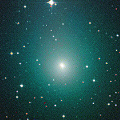
|
It brightened up to 8.3 mag in September (Sept. 20, Maik Meyer). Now it is fading. It has already faded down to 13.1 mag (Nov. 19, Chris Wyatt). In the Southern Hemisphere, it stays observable for a long time after this. In the Northern Hemisphere, it will never be observable again.
Date(TT) R.A. (2000) Decl. Delta r Elong. m1 Best Time(A, h)
Dec. 21 21 51.01 -45 39.1 2.512 2.063 52 13.9 20:59 ( 54, 33)
Dec. 28 21 57.40 -46 1.2 2.654 2.128 48 14.2 21:03 ( 52, 29)
|
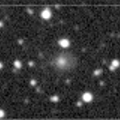
|
Now it is bright as 13.5 mag (Dec. 4, Chris Wyatt). It stays 14 mag until spring. It stays observable for a long time in the Southern Hemisphere. It is not observable until August in the Northern Hemisphere.
Date(TT) R.A. (2000) Decl. Delta r Elong. m1 Best Time(A, h)
Dec. 21 19 57.05 -86 7.4 3.772 3.443 63 14.0 20:59 ( 5, 34)
Dec. 28 22 5.95 -84 17.6 3.771 3.447 63 14.0 21:03 ( 7, 36)
|
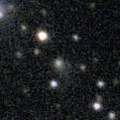
|
Now it is 14.5 mag (Nov. 28, Toshihiko Ikemura, Hirohisa Sato). In the Northern Hemisphere, it is observable at 14 mag in excellent condition in winter. It locates low in the Southern Hemisphere.
Date(TT) R.A. (2000) Decl. Delta r Elong. m1 Best Time(A, h)
Dec. 21 2 29.05 30 2.4 0.748 1.598 134 14.4 20:59 (173, 25)
Dec. 28 2 38.58 27 22.0 0.773 1.589 129 14.5 21:03 (168, 27)
|
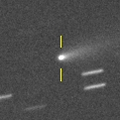
|
Now it is 15.4 mag (Dec. 4, Chris Wyatt). It is observable at 14.5 mag in good condition in winter. It locates somewhat low in the Southern Hemisphere.
Date(TT) R.A. (2000) Decl. Delta r Elong. m1 Best Time(A, h)
Dec. 21 10 59.11 11 56.9 1.297 1.844 107 14.5 2:55 (219, 34)
Dec. 28 11 8.50 11 44.4 1.255 1.862 111 14.5 2:59 (213, 37)
|
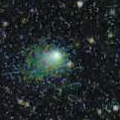
|
Now it is 14.0 mag (Nov. 29, Toshihiko Ikemura, Hirohisa Sato). It will be fading slowly after this.
Date(TT) R.A. (2000) Decl. Delta r Elong. m1 Best Time(A, h)
Dec. 21 21 43.46 -12 46.1 2.217 1.844 55 14.5 20:59 ( 86, 17)
Dec. 28 22 1.75 -11 45.4 2.285 1.862 52 14.7 21:03 ( 85, 14)
|
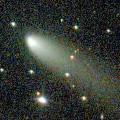
|
It brightened up to 11.4 mag in autumn (Nov. 10, Carlos Labordena). It will fade out rapidly after this. It has already faded down to 13.2 mag (Dec. 5, Thomas Lehmann). It is observable in excellent condition in the Northern Hemisphere. It stays locating extremely low in the Southern Hemisphere.
Date(TT) R.A. (2000) Decl. Delta r Elong. m1 Best Time(A, h)
Dec. 21 2 34.86 45 25.2 0.966 1.798 134 14.7 20:59 (176, 9)
Dec. 28 2 42.28 44 19.6 1.046 1.842 130 15.2 21:03 (172, 10)
|

|
In the Southern Hemisphere, it is observable at 14.5 mag from winter to spring. In the Northern Hemisphere, it is not observable until August when it fades down to 17 mag.
Date(TT) R.A. (2000) Decl. Delta r Elong. m1 Best Time(A, h)
Dec. 21 17 12.04 -65 15.0 2.735 2.115 42 14.9 2:55 (339, 19)
Dec. 28 17 41.36 -67 48.6 2.667 2.091 44 14.8 2:59 (341, 21)
|

|
Now it is 14.2 mag (Dec. 2, Chris Wyatt). It will be fading slowly after this. In the Southern Hemisphere, it becomes low from February to March, but it stays observable for a long time. In the Northern Hemisphere, it is not observasble until summer in 2020.
Date(TT) R.A. (2000) Decl. Delta r Elong. m1 Best Time(A, h)
Dec. 21 21 50.69 -63 20.6 3.784 3.328 55 14.9 20:59 ( 33, 37)
Dec. 28 22 1.25 -60 45.0 3.859 3.353 52 15.0 21:03 ( 36, 34)
|
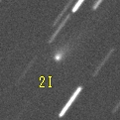
|
Now it is 14.7 mag (Nov. 29, Toshihiko Ikemura, Hirohisa Sato). The orbit is extremely hyperbolic with e=3.35. It is the first interstellar comet in history. It stays 15 mag until January. In the Northern Hemisphere, it will be getting lower after this, and it will be unobservable in mid January. In the Southern Hemisphere, it will be getting higher gradually. Then it will be observable in excellent condition.
Date(TT) R.A. (2000) Decl. Delta r Elong. m1 Best Time(A, h)
Dec. 21 11 48.67 -27 53.8 1.944 2.026 80 15.0 2:55 (272, 52)
Dec. 28 11 59.63 -33 9.5 1.937 2.053 82 15.1 2:59 (278, 58)
|
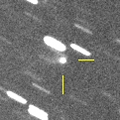
|
Now it is 14.8 mag (Dec. 1, Toshihiko Ikemura, Hirohisa Sato). It stays at 14.5-15 mag until December. It is observable in good condition in the Southern Hemisphere. It locates somewhat low in the Northern Hemisphere.
Date(TT) R.A. (2000) Decl. Delta r Elong. m1 Best Time(A, h)
Dec. 21 21 49.35 -7 53.7 2.103 1.796 58 15.0 20:59 ( 91, 15)
Dec. 28 22 5.19 -5 48.5 2.163 1.803 55 15.2 21:03 ( 91, 11)
|

|
It brightened up to 7.7 mag in June in 2018 (June 19, Juan Jose Gonzalez). Now it is fading. It has already faded down to 15.1 mag (Nov. 6, Toshihiko Ikemura, Hirohisa Sato). In the Southern Hemisphere, it stays observable for a long time until the comet will fade out. In the Northern Hemisphere, it stays low for a while.
Date(TT) R.A. (2000) Decl. Delta r Elong. m1 Best Time(A, h)
Dec. 21 6 13.30 -33 40.1 4.941 5.535 122 15.1 0:18 (180, 89)
Dec. 28 6 6.53 -33 2.4 4.988 5.591 123 15.2 23:39 (180, 88)
|

|
Now it is 15.7 mag (Nov. 29, Toshihiko Ikemura, Hirohisa Sato). It will be fading gradually after this. It will be fainter than 18 mag in April.
Date(TT) R.A. (2000) Decl. Delta r Elong. m1 Best Time(A, h)
Dec. 21 9 39.65 5 27.3 2.175 2.831 122 15.2 2:55 (199, 48)
Dec. 28 9 38.02 5 20.7 2.129 2.863 130 15.3 2:59 (186, 50)
|
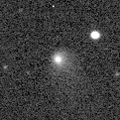
|
Now it is 14.7 mag (Nov. 19, Chris Wyatt). In the Southern Hemisphere, it is observable for a long time. It stays low in the Northern Hemisphere.
Date(TT) R.A. (2000) Decl. Delta r Elong. m1 Best Time(A, h)
Dec. 21 22 59.19 -26 59.1 5.064 4.786 68 15.6 20:59 ( 82, 39)
Dec. 28 23 2.32 -25 37.5 5.194 4.819 62 15.7 21:03 ( 80, 33)
|

|
Now it is 17.2 mag (Nov. 28, Toshihiko Ikemura, Hirohisa Sato). It will brighten up to 13.5-14 mag from 2020 to 2021. It stays observable in good condition for a long time after this until 2020 summer.
Date(TT) R.A. (2000) Decl. Delta r Elong. m1 Best Time(A, h)
Dec. 21 12 52.29 11 43.4 3.591 3.581 81 16.0 2:55 (243, 16)
Dec. 28 12 57.83 11 37.2 3.475 3.564 87 15.8 2:59 (238, 21)
|
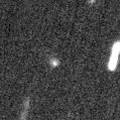
|
Now it is 16.7 mag (Nov. 1, Ken-ichi Kadota). It will brighten up to 10.5 mag from 2020 December to 2021 January. In the Northern Hemisphere, it stays observable in good condition while the comet will be brightening gradually, but it is not observable at the high light. In the Southern Hemisphere, it is not observable for a long time, but it will be observable in good condition after the high light.
Date(TT) R.A. (2000) Decl. Delta r Elong. m1 Best Time(A, h)
Dec. 21 17 35.95 60 36.4 4.348 4.359 84 16.1 2:55 (215,-50)
Dec. 28 17 43.97 60 23.5 4.283 4.295 84 16.0 2:59 (216,-47)
|

|
It will be fading slowly after this. In the Southern Hemisphere, it stays observable in good condition for a long time, although it becomes low from October to November. It will never be observable after this in the Northern Hemisphere.
Date(TT) R.A. (2000) Decl. Delta r Elong. m1 Best Time(A, h)
Dec. 21 14 30.07 -59 26.0 5.064 4.502 50 16.1 2:55 (323, 32)
Dec. 28 14 31.90 -60 59.9 5.045 4.545 54 16.1 2:59 (324, 36)
|
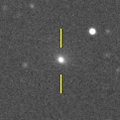
|
Now it is 16.0 mag (Nov. 28, Toshihiko Ikemura, Hirohisa Sato). It stays 15-16 mag until December, and it is observable in good condition.
Date(TT) R.A. (2000) Decl. Delta r Elong. m1 Best Time(A, h)
Dec. 21 0 14.01 -4 41.0 2.090 2.353 92 16.1 20:59 (119, 41)
Dec. 28 0 22.34 -3 32.8 2.167 2.349 88 16.1 21:03 (116, 37)
|

|
Now it is 16.7 mag (Nov. 14, Thomas Lehmann). It is expected to be observable at 5-6 mag for a long time from 2022 to 2023. In the Northern Hemisphere, it is not observable at the high light from 2022 summer to 2023 summer. In the Southern Hemisphere, it stays unobservable for a while. But it will be observable in good condition at the high light.
Date(TT) R.A. (2000) Decl. Delta r Elong. m1 Best Time(A, h)
Dec. 21 17 43.50 45 30.5 10.508 10.197 68 16.2 2:55 (239,-53)
Dec. 28 17 47.33 45 25.0 10.455 10.148 69 16.2 2:59 (239,-48)
|
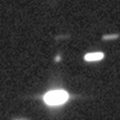
|
It will brighten up to 13 mag in 2021. In 2020, it is observable at 15 mag in good condition from spring to summer.
Date(TT) R.A. (2000) Decl. Delta r Elong. m1 Best Time(A, h)
Dec. 21 14 43.49 -10 44.4 6.567 5.939 46 16.8 2:55 (278, 8)
Dec. 28 14 47.05 -11 21.5 6.435 5.895 52 16.7 2:59 (275, 14)
|

|
Now it is 17.4 mag (Dec. 4, Toshihiko Ikemura, Hirohisa Sato). It stays 16-17 mag for a long time until 2020. It is observable in good condition in the Northern Hemisphere. It is hardly observable in the Southern Hemisphere.
Date(TT) R.A. (2000) Decl. Delta r Elong. m1 Best Time(A, h)
Dec. 21 13 23.27 52 12.3 8.472 8.626 95 16.8 2:55 (216,-15)
Dec. 28 13 25.92 52 28.6 8.416 8.634 99 16.8 2:59 (213,-12)
|

|
Fading. Now it is 17.6 mag (Nov. 28, Toshihiko Ikemura, Hirohisa Sato). It stays 17 mag from autumn to winter. It is observable in good condition in the Northern Hemisphere. It locates low in the Southern Hemisphere.
Date(TT) R.A. (2000) Decl. Delta r Elong. m1 Best Time(A, h)
Dec. 21 8 55.09 23 46.6 5.937 6.707 138 17.0 2:55 (181, 31)
Dec. 28 8 49.36 23 50.0 5.905 6.751 146 17.0 2:27 (180, 31)
|

|
Now it is 16.0 mag (Nov. 29, Toshihiko Ikemura, Hirohisa Sato). It stays bright even after the perihelion passage. It will fade out rapidly after this, and it will be fainter than 18 mag in January. However, it may stay bright for some more time.
Date(TT) R.A. (2000) Decl. Delta r Elong. m1 Best Time(A, h)
Dec. 21 3 8.45 -1 28.2 2.159 2.918 132 17.2 21:10 (180, 56)
Dec. 28 3 8.97 -1 0.9 2.279 2.972 126 17.4 21:03 (171, 56)
|

|
Now it is 16.5 mag (Nov. 29, Toshihiko Ikemura, Hirohisa Sato). It will be fading after this, and it will be fainter than 18 mag in January.
Date(TT) R.A. (2000) Decl. Delta r Elong. m1 Best Time(A, h)
Dec. 21 1 14.95 -7 13.4 2.303 2.734 105 17.2 20:59 (133, 53)
Dec. 28 1 5.82 -7 52.0 2.484 2.769 96 17.4 21:03 (121, 47)
|
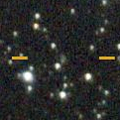
|
Now it is 17.3 mag (Nov. 30, Toshihiko Ikemura, Hirohisa Sato). It will brighten up to 12 mag in winter in 2022.
Date(TT) R.A. (2000) Decl. Delta r Elong. m1 Best Time(A, h)
Dec. 21 22 11.32 41 12.5 7.184 7.216 87 17.4 20:59 (133,-11)
Dec. 28 22 14.79 40 54.1 7.215 7.170 83 17.3 21:03 (130,-15)
|
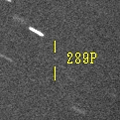
|
It brighted rapidly from 20.5 mag up to 18.5 mag in September. However, the brightness evolution has stopped since October. Now it is very faint as 18.9 mag (Nov. 21, Katsumi Yoshimoto). It will approaches to Earth down to 0.09 a.u. in early January, and it will brighten up to 15.5 mag. It will be obesrvable in excellent condition in the Northern Hemisphere. In the Southern Hemisphere, it will not be observable at the high light.
Date(TT) R.A. (2000) Decl. Delta r Elong. m1 Best Time(A, h)
Dec. 21 22 56.13 -0 34.1 0.169 0.959 76 17.9 20:59 (108, 24)
Dec. 28 23 11.80 10 27.1 0.133 0.964 77 17.4 21:03 (115, 14)
|
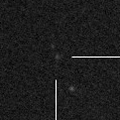
|
Now it is 17.4 mag (Oct. 31, Ken-ichi Kadota). It is observable at 17-18 mag for a long time from late 2019 to early 2021. It will fade out before it passes the perihelion.
Date(TT) R.A. (2000) Decl. Delta r Elong. m1 Best Time(A, h)
Dec. 21 2 54.99 1 2.7 4.403 5.106 131 17.5 20:59 (179, 54)
Dec. 28 2 53.22 1 20.0 4.473 5.093 124 17.5 21:03 (165, 53)
|
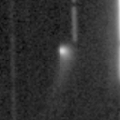
|
Now it is 17.3 mag (Nov. 29, Toshihiko Ikemura, Hirohisa Sato). It will be fading after this. In the Northern Hemisphere, it stays observable in good condition for a long time. In the Southern Hemisphere, it stays extremely low for a long time.
Date(TT) R.A. (2000) Decl. Delta r Elong. m1 Best Time(A, h)
Dec. 21 1 2.10 29 50.9 4.023 4.536 115 17.6 20:59 (153, 20)
Dec. 28 0 59.08 28 14.6 4.178 4.578 107 17.7 21:03 (146, 18)
|

|
Fading now. Now it is 17.1 mag (Oct. 5, M. Masek). In the Southern Hemisphere, it stays observable for a long time until it fades out. In the Northern Hemisphere, it will not be observable after this.
Date(TT) R.A. (2000) Decl. Delta r Elong. m1 Best Time(A, h)
Dec. 21 5 12.35 -55 56.1 5.397 5.654 100 17.7 23:12 ( 0, 69)
Dec. 28 5 1.19 -55 55.7 5.472 5.706 98 17.8 22:33 ( 0, 69)
|

|
It will brighten up to 8-9 mag from summer to autumn. It will be observable in excellent condition in the Southern Hemisphere. It locates very low around the high light in the Northern Hemisphere.
Date(TT) R.A. (2000) Decl. Delta r Elong. m1 Best Time(A, h)
Dec. 21 12 57.11 -2 2.7 2.980 2.880 74 18.0 2:55 (255, 24)
Dec. 28 13 4.38 -2 42.9 2.842 2.838 79 17.7 2:59 (251, 29)
|
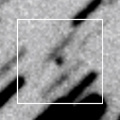
|
Asteroid moving along a comet-like orbit. Now it is 16.9 mag (Dec. 3, Toshihiko Ikemura, Hirohisa Sato). It stays observable at 17.5 mag from 2020 to 2021. It locates somewhat low in the Northern Hemisphere.
Date(TT) R.A. (2000) Decl. Delta r Elong. m1 Best Time(A, h)
Dec. 21 10 58.07 -24 4.7 6.532 6.643 92 17.8 2:55 (257, 60)
Dec. 28 10 59.20 -24 27.5 6.427 6.637 98 17.7 2:59 (250, 67)
|
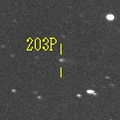
|
Now it is 17.2 mag (Dec. 2, Toshihiko Ikemura, Hirohisa Sato). It is observable at 17-18 mag in good condition in winter. It locates somewhat low in the Southern Hemisphere.
Date(TT) R.A. (2000) Decl. Delta r Elong. m1 Best Time(A, h)
Dec. 21 4 1.34 23 21.5 2.310 3.225 154 17.8 22:02 (180, 32)
Dec. 28 3 58.18 23 4.7 2.355 3.221 146 17.8 21:32 (180, 32)
|

|
It brightened up to 14 mag from autumn to winter in 2018. Now it is fading. It is observable at 17.5 mag in good condition from winter to spring.
Date(TT) R.A. (2000) Decl. Delta r Elong. m1 Best Time(A, h)
Dec. 21 13 39.46 -0 22.0 4.396 4.091 65 17.8 2:55 (260, 15)
Dec. 28 13 42.66 -0 55.6 4.334 4.133 71 17.8 2:59 (256, 21)
|
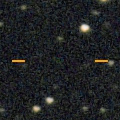
|
Now it is very faint as 19.7 mag (Oct. 25, Toshihiko Ikemura, Hirohisa Sato). It brightened up to 15.5 mag in 1997, and 17 mag in 2008, however, it is much fainter in this apparition.
Date(TT) R.A. (2000) Decl. Delta r Elong. m1 Best Time(A, h)
Dec. 21 1 9.34 12 17.5 2.896 3.390 112 20.6 20:59 (147, 36)
Dec. 28 1 12.47 12 8.5 3.000 3.399 105 20.7 21:03 (139, 33)
|
|
![]()
 A/2019 C1
A/2019 C1 203P/Korlevic
203P/Korlevic (944) Hidalgo
(944) Hidalgo 200P/Larsen
200P/Larsen![]()

































